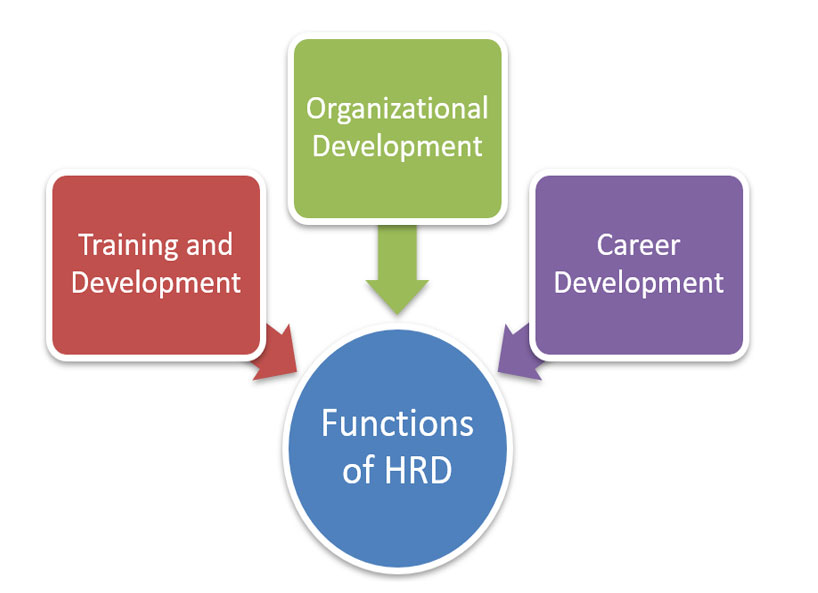Human Resource Development (HRD): Definition, Process, Functions: An integral part of Human Resource Management which deals with the training and development of employees within the organization is known as Human resource development. HRD is associated with providing training to the employees when they get hired, distribution of resources that are beneficial for the management of employee’s tasks, offering opportunities for growth and learn some new skills.

Pic Credit: Unsplash
If an organization would like to be more dynamic and growth-oriented, then the development activities of human resources are necessary for the organization. Apart from the resources, human resources have the potential abilities to develop employees. The potential can be also used by creating a positive atmosphere to identify, nurture as well as efficiently use the skills of people. HRD system aims to create such a climate and counts of techniques are used to perform all the tasks in a well-defined way by following certain principles.
Also See: Importance of Recruitment and Why It Is Needed?
Human Resource Development (HRD): Definition, Process, Functions
In this article, we are going to understand the concept of HRD System and all related procedures within the boundaries of Human Resource Development.
Definitions of HRD
Various scholars have defined the term “Human Resource Development” based on their perspective. Important definitions of HRD are as follows:
- Leonard Nadler defined, “Human Resource Development is a series of organized activities, conducted within a specialized time and designed to produce behavioral change.”
- As per M. M. Khan, “Human Resource Development is the across of increasing knowledge, capabilities and positive work attitudes of all people working at all levels in a business undertaking.”
The concept of the Human Resource Department
HRD is an organizational context which is a process through which required help is provided to the employees of an organization in a continuous and well-planned manner to:
- Obtain or boost capabilities needed to perform several functions attached to their present or desired future roles;
- Enhance their general abilities as individuals and discover as well as explore their inner potentials for organizational purposes and employee’s development; and
- Develop a culture in an organization under which a strong relationship between the employee-employer is established and all the members work in a team and give professional well-being and motivation among employees.
HRD is a whole process and not a blend of mechanisms and techniques. All the mechanisms and techniques such as performance appraisal, counseling, training, and organizational development interventions are used to facilitate and promote the process in a continuous manner. The process is limitless and there is a need to examine the mechanism periodically and to sort out the issues attached to hinder the process. The process of HRD facilitates the organization and allocates organizational resources for the motives as well as evaluating the HRD philosophy.
Also See: Recruitment and Selection Process: Complete Guide
The Process of Human Resource Development
The highlighted aim of Human Resource Development is to enhance the workforce that will allow the organization to accomplish the objectives and offer the best to their potential customers. HRD process can be done both internally as well as externally from within the organization. Formally, it can be easily done through providing classroom training to employees, planned change in organization and train the employees on a definite issue. The process of HRD is associated with the role of HRM and deals with all the matters of the employees. Here, we are jotting down the strategic role of HRM and tactics in which HRD’s strategic approach can act as strategic roles within the organization. Let us have a look at these below.
Strategic Human Resource Management
It is a planned move based on which the employees of an organization are managed. The employees of an organization are known as human resources. The term strategic is a basic function of the Human Resource Management which comprises of devising as well as implementing the consistent organizational policies with the structure of the organization and make sure that the human capital is working efficiently towards the goals of the organization and achieve the set target promptly. The entire process is strategic as it takes the internal structure of the organization into account along with the organization’s resources and the nature of the human capital in the organization.
It is also observed that the HRD process is technical and the technical HRM involves the basic roles of HRM like recruitment, selection, and training. Therefore, Strategic HRM is a result of combining the basic roles to fit the business strategy. This adds on more flexibility among the employees and also utilizing them with a motive of accomplishing the organizational goals.
The strategic HRM emphasizes building up ideas and capacity in the organization that will allow it to hold up with the changes in the external market. An organization with a pool of human resources who have sufficient skills and knowledge in line with organizational strategies act as an avenue to accomplishing the goals of an organization.
HRM Strategy
All the HRM functions that are in line with the strategies of the organization are to be implemented by the HRM strategy. HRM strategy considers bunches of factors that consist of best fit, best practices, and close cooperation and monitoring continuously. “Best fit and best practices” refers to the correlation between the HRM strategy and the whole strategy of the organization. The primary motive of Human Resource Management is to handle the employees of organization however strategy HRM deals by applying the requirements of the personnel of an organization with the organizational goals.
To exemplify, the organizational motive is to maximize its sales by twenty percent and the practices will adopt as per the fulfillment of the objective and do the best possible to achieve the same.
Close Cooperation refers to maintain a proper between Human Resources and the top management of the organization to develop a particular organizational strategy. Organizational management is always a part of the implementation of strategies as they are ones who provide goods and services as required in the whole process.
Continuous Monitoring helps the organization to keep a check over the difficulties that hinder the process of HRM that may require the interference of the senior management.
Strategic Planning
Strategic planning relates to the determination of the current position where they want to head and in what way they will reach over there. This type of planning varies according to the organization. For instance, it is done through senior management, supervisors of different departments and employees too in some organization but in others, it is the responsibility of the senior management only.
According to the process of Strategic Planning, the top-level management needs to get a crystal clear vision of the organization. This is the endpoint where an organization has lasted in the long run. A leader ought to be appointed by the management to give a proper direction to the implementation of the whole process.
Strategic Training
Training is the procedure of making intrusions that are aimed at making improvements in the skills, knowledge, and abilities of the employees within an organization. Before the commencement of the training to employees, the management needs to make sure that all the training requirements and designing of the program have been done with the proper evaluation of the training process. This strategic training is provided to the employees on the issues that can impact the organizational goals. In line with the organizational goals, the designing of training is done in a manner that includes the identification of objectives and the topics will cover in the training program accordingly.
It is vital to measure the success of the training after it has done. So that it is easy to determine the invested time and efforts and also, about the payback of the training program.
The previously set target is the basis of gauging the effectiveness of training and how long it takes to achieve the objectives. Moreover, proper feedback from the students in the training program is another way to measure success. Apart from this, assessing the behavioral change and also the impact on organization become another measure for effectiveness. It can also reflect in some aspects of the organization such as level of productivity, sales volume, profit earned and satisfaction of customers.
The connection between Strategic HRM and HRD
One of the functions of Human Resource Management is the Human Resource Development. HRD is designed to provide up to date proficiencies and knowledge to the employees and give support to various activities of the organization. A fundamental role is played by HRD in organizational strategy and continuous formulation of the organizational strategies. To stand out better in the highly competitive world, an organization requires having the quality of employees with expert knowledge and skills.
Functions Of Human Resource Management
The functions of HRD involve training and development, organizational development and professional enhancement of an employee on their career path.

Training and development is a proper way to convey the employees about the definite set of abilities and knowledge with the changing competition in the market. When there is any deficiency find in the performance of the employees, then the organization develops some training and development programs.
Standard Performance – Actual performance = Training and Development
Development refers to create new opportunities that may help the employees to grow. It does not include any improvements in skills but providing a change in the attitude of the employees. It is not compulsory in some cases to provide the various development activities. Training and development programs are offered to add value to the skills and knowledge of existing employees.
Organizational Development leads to make improvements in the organizational situations and for the well being of the employees. It is a kind of response towards the change by doing changes in the structure of the organization, opt for the latest technologies and face the new challenges related to an organization.
A continuous process is known as Career development under which the employees go through the different changes until and unless they obtain the maximum level of achievement. Organizations are also designed some programs for the career development of employees and help them to attain the maximum potential.
Wrapping Up
To encapsulate, strategic human resource development is the main function of strategic human resource management which plays an important role in organizational success. If all employees directed towards the goals of the organization, then they can achieve the objectives but proper development in skills, as well as knowledge, is also required. Strategic planning and training are done in a manner the employees do not deviate from their vision of accomplishing the goals.